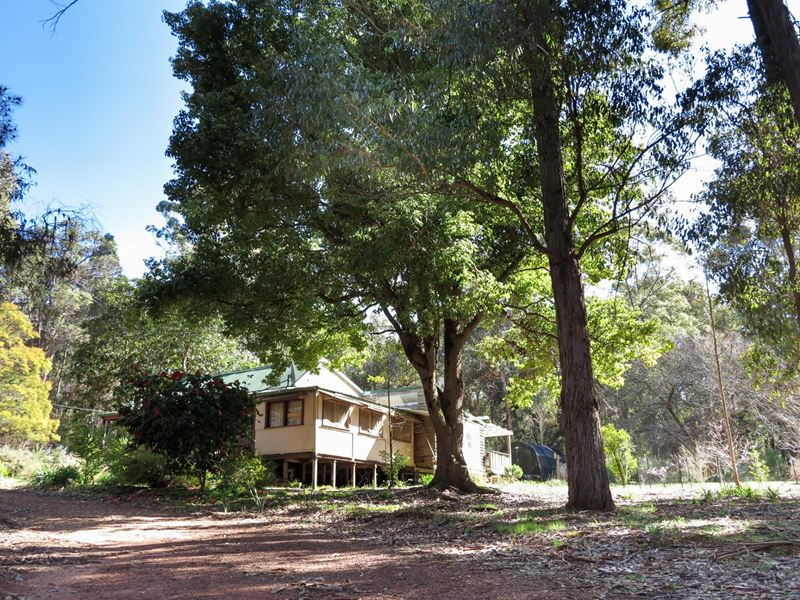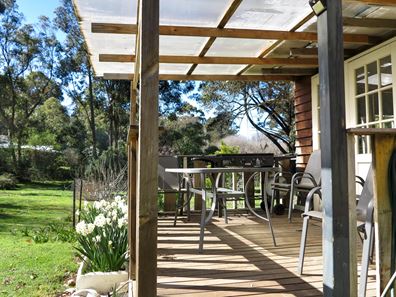Dwellingup retreat now and then for the family and collect the cash when your not there.
This 1940 built home, continues to be a well booked accommodation venue, returning approximately $32,500 in the last 15 months via AIRBNB, providing a generous "accountable" income for those wishing to hold on to the property for lifestyle changes in the pipeline or pass on to their family in years to come.
The 2 acre property on the high side of Holyoake Road, certainly brings with it a secluded and private feel and is still less than an hour and 20 minutes from Perth.
Leave the city rat race behind and create a new life for you and your family, or just come down and enjoy the many mountain bike trails and walks on the weekends.
Fully fenced in and surrounded by state forest on two sides, you are able to take your children and or pets with you and let them run around.
The bush land setting and tranquil location offers a large array of flora and fauna, while active beehives are also utilised in this environment.
Spend the weekend away and sit on the veranda and enjoy the peace and quiet whilst you pick fruits from the various citrus trees that sprinkle the property.
Whilst, you can getaway from your busy lives here, Dwellingup town is only minutes walking distance away in case you need a shot of urbanisation.
- 8116 sqm [2 acres]
- 2 Bedroom
- Bathroom
- Large shed
- Council rates $1,874.82 p/a
Property features
-
Garages 1
-
Toilets 1
-
Floor area 117m2
Property snapshot by reiwa.com
This property at 195 Holyoake Road, Dwellingup is a two bedroom, one bathroom house sold by Dino Brescacin at Acton | Belle Property Dalkeith on 02 Oct 2023.
Looking to buy a similar property in the area? View other two bedroom properties for sale in Dwellingup or see other recently sold properties in Dwellingup.
Cost breakdown
-
Council rates: $1,874 / year
-
Water rates: $275 / year
Nearby schools
Dwellingup overview
Dwellingup is located in a timber and fruitgrowing area in the Darling Range ESE of Pinjarra. Townsite lots were surveyed at this place by Surveyor W.F. Rudall in 1909 after the Lands Department became aware that the site was planned as the terminus of the "Pinjarra-Marrinup Railway". Names suggested for the place by Rudall were "Dwellingerup" or "Marrinup", after nearby brooks, or "McLarty" after a local MLA who had been very active concerning the railway. Surveyor General H.F. Johnston chose "Dwellingupp" after being misinformed regarding the spelling of Dwellingerup Brook. Ignoring a suggestion from the Under Secretary to amend the name to "Dwellingdown", the Minister for Lands approved the name as "Dwellingup" in December 1909. Eventually, the spelling "Dwellingupp" was chosen by order of the Under Secretary for Lands, and the townsite was gazetted as Dwellingupp in February 1910. The spelling was amended to Dwellingup in 1915. Dwellingup is an Aboriginal name said to mean "place of nearby water". The town was burnt out by a bushfire in 1961 but was rebuilt.
The double 'p' spelling in the original gazettal of this name was used because the Lands and Surveys Department had adopted a system for spelling Aboriginal names developed by the Royal Geographical Society. A number of Aboriginal names ending in "up" were for a time spelt with the "upp" ending (including Kirupp, Kulikupp, Manjimupp and Mungalupp). The RGS system had a rule that vowels are pronounced as in Italian and consonants as in English. This would have meant that names ending in "up" should have been pronounced as "oop", because the Italian "u" was a long "u", as in flute. These Aboriginal names were meant to be pronounced as "up", and the Department asked the RGS for a rule to assist in correct pronunciation. The RGS solution was that doubling the following consonant shortened the preceding vowel, and this meant the "upp" ending ensured the "up" pronunciation. However, this particular rule was rescinded in 1915 for SW towns with the suffix "up", as the Australian way of pronouncing the letter "u" was almost always short, and rarely the Italian "oo".





